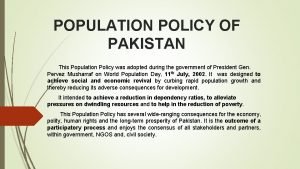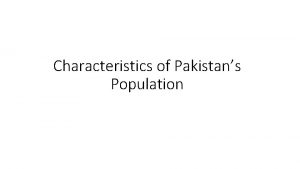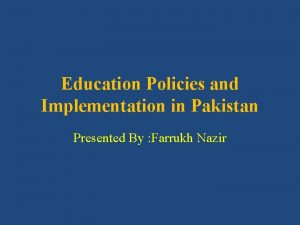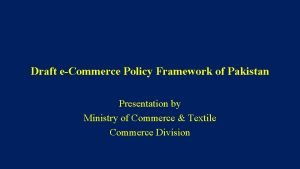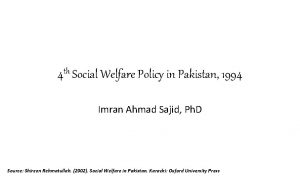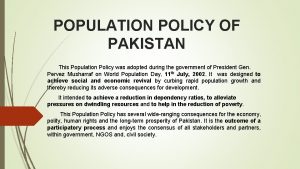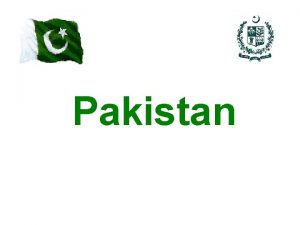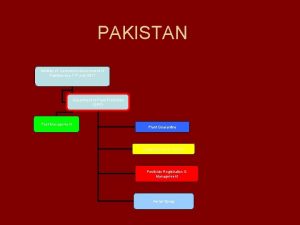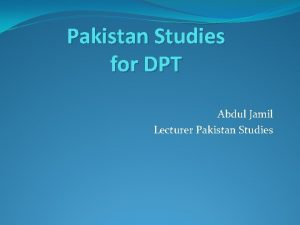POPULATION POLICY OF PAKISTAN This Population Policy was











- Slides: 11

POPULATION POLICY OF PAKISTAN This Population Policy was adopted during the government of President Gen. Pervez Musharraf on World Population Day, 11 th July, 2002. It was designed to achieve social and economic revival by curbing rapid population growth and thereby reducing its adverse consequences for development. It intended to achieve a reduction in dependency ratios, to alleviate pressures on dwindling resources and to help in the reduction of poverty. This Population Policy has several wide-ranging consequences for the economy, polity, human rights and the long-term prosperity of Pakistan. It is the outcome of a participatory process and enjoys the consensus of all stakeholders and partners, within government, NGOS and, civil society.

VISION “ The overall vision of the Population Policy is to achieve population stabilization by 2020 through the expeditious completion of the demographic transition that entails declines both in fertility and mortality rates”. GOALS The following are the goals added in the Population Policy : - Ø Attain a balance between resources and population within the broad parameters of the ICPD paradigm. Ø Address various dimensions of the population issue within national laws, development priorities while remaining within our national social and cultural norms. Ø Increase awareness of the adverse consequences of rapid population growth both at the national, provincial, district and community levels Ø Promote family planning as an entitlement based on informed and voluntary choice. Ø Attain a reduction in fertility through improvement in access and quality of reproductive health services. Ø Reduce population momentum through a delay in the first birth, changing spacing patterns and reduction in family size desires.

STRATEGIES Develop and launch advocacy campaigns to address special groups, such as, policy makers, opinion leaders, youth and adolescents. Increase ownership of population issues by the stakeholders and strengthen their participation in the processes of service delivery and program design. Reduce unmet need for family planning services by making available quality family planning & RH services to all married couples who want to limit or space their children. Adopt a shift from target oriented to people-centered needs and services. Ensure the provision of quality services especially to the poor, under-served and un-served populations in rural areas and urban slums. Coordinate and monitor a comprehensive network of family planning & RH services. Build strong partnerships with concerned Line Ministries, Provincial line Departments particularly Health, Non-Governmental Organizations and the private Sector including the industrial sector to maintain standards in family planning by providing assistance/guidance through advocacy, training, monitoring and other means of participation and quality assurance.

Cont Strengthen contribution to population activities by civil society players, particularly NGOs and media. Expand the role of the private sector by making contraceptives accessible and affordable of contraceptives through social marketing of contraceptives and through local manufacture of contraceptives. Decentralize program management and service delivery to provincial and district levels.

AREAS OF POLICY FOCUS This Policy was developed and coordinated through a multi-sectoral strategy towards population issues in which there was a synergy between population dynamics, economic revival and poverty alleviation programs. So the main areas of policy Focus along with their provisions are discussed as follows: 1) Service Delivery Expansion and Improvement of Quality: Service provision in family planning & RH will concentrate on improving access & expanding coverage with special emphasis on rural & under served areas and slums. This will be achieved through Population Welfare Program’s infrastructure & through the health service delivery infrastructure, partnerships with private sector and networking with civil society. The provision of family planning service will include RH, counselling services for attitudinal change for enhanced family planning practice and ensuring adequate supplies. Contraceptive choice is to be widened by providing training to service provider in latest techniques. Quality service provision will be ensured through regular monitoring.

Cont It will specifically include: Ø Strengthening Community-Based Services Ø Linkages with Institutional Service Delivery System Ø Strengthening and upgrading the existing Family Welfare Centers Ø Public-Private Partnerships Ø Male Involvement Ø Improve and Ensure Quality of Services 2) Advocacy programmes will utilize all channels of communication particularly the media, interpersonal communication and mass education to convey the macro and micro effects of runaway population growth.

Cont It will address the public and various influential groups as follows: Ø Public Representatives: will be given orientations on the population problem and its critical link to social and economic progress. They will be invited in turn to be advocates of the programme. Ø Policy/Decision Makers: will be targeted to enhance their understanding of the inter-linkages between population and sustainable development, to integrate population variable into their sectoral planning, commit increased level of resources and extend overall support to the population sector. Ø Opinion Leaders: will be sensitized about the continued benefit of birth spacing, safe motherhood and responsible parenthood for enriching and improving the quality of life. Ø Men: Males will be sensitized that family planning is a need for their own health and family well being. Ø Youth & Adolescents: Youth are the future generation and need to be sensitized about the wideranging consequences of rapid population growth for the individual, family and nation and, therefore the need to build a mindset for responsible parenthood. Ø Medical Profession: medics and paramedics will be motivated to accept family planning as integral to the work of their profession, particularly in the context of primary health care.

Cont Ø Organized Sector: Organized sector is to be associated as a partner to educate, inform and provide services to their employees through their infrastructure in family planning & RH. Ø Intelligentsia/Influential Groups: will be provided information about inter-relationships between population and sustainable development to sustain awareness, understanding and enhance social acceptability of the programme in society. 3) Training and Capacity Building The following training programme and human resource development would be key features of the strategy: a) Family Planning Training: Population Welfare Programme has a nationwide institutional set-up of Training Institutes. They are equipped not only to provide pre-service and in-service training to all population welfare training personnel but also on an organized basis respond to the training needs of nation building departments, public sector organizations and NGOs.

b) Human Resource Development (HRD): A Human Resource Development Plan will be prepared for programme personnel. This has assumed added importance because of the need for re-training in new skills and management approaches. In addition, there has been neglect in maintaining the level of programme staff which is currently denuded due to superannuation and limited recruitment. As a starting point under the devolution plan, District Government personnel will be retrained in new methodologies of planning, coordination functions, problem-solving skills and improving their capacity to manage activities relating to the population sector. 4) Decentralization The Program which to date has been federal will be defederalized with administrative, financial & programme transfers to the provinces: The defederalization will further decentralize the program to the District level in line with Governments devolution plan. This will be done through subsidiarity of the Population Welfare Program at the district level. In addition, Health Departments are mandated to provide family planning services in the primary health care infrastructure.

5) Coordination The Policy recognizes that population is a crosscutting issue, which cannot be addressed in isolation and warrants an institutionalized coordinating mechanism. Coordination is required at all levels within the government and outside and with all stakeholders. This function rests with the Population Welfare Division. 6) MONITORING MECHANISMS The following interventions would be critical for an effective monitoring and evaluation mechanism: Ø Management Information System Ø Logistic Management Information System Ø GIS /Mapping Ø Research in Population and Development Ø Funding

Source: Punjab Population Welfare Department. (n. d. ). Population Policy 2002. Retrieved April 26, 2020, from https: //www. easy-sol. com/profile/population/pages/policy. html
 Population policy of pakistan
Population policy of pakistan Characteristics of pakistan
Characteristics of pakistan Pakistan hindu population 2020
Pakistan hindu population 2020 Educational policy 1998 to 2010
Educational policy 1998 to 2010 Cloud policy pakistan
Cloud policy pakistan 2nd social welfare policy in pakistan
2nd social welfare policy in pakistan Language policy in pakistan slideshare
Language policy in pakistan slideshare Chapter test a chapter 4 population ecology answer key
Chapter test a chapter 4 population ecology answer key Section 1 population dynamics answer key
Section 1 population dynamics answer key Population ecology section 1 population dynamics
Population ecology section 1 population dynamics Chapter 4 population ecology section 1 population dynamics
Chapter 4 population ecology section 1 population dynamics Presents from my aunts in pakistan
Presents from my aunts in pakistan
